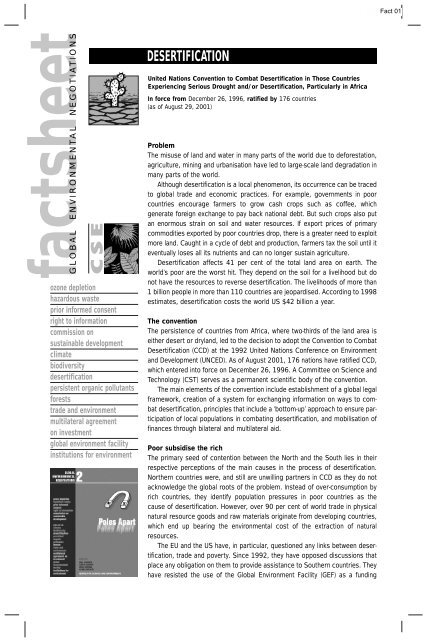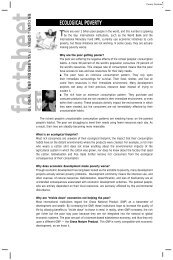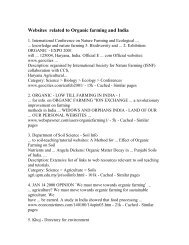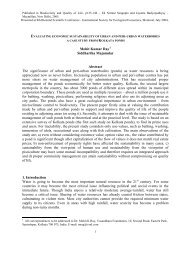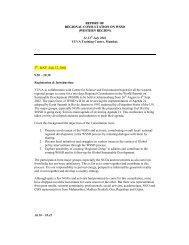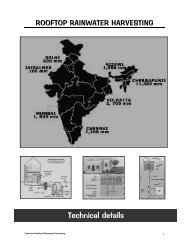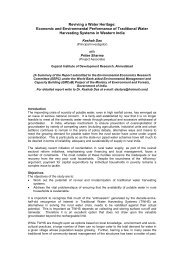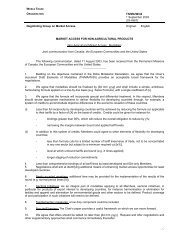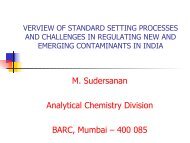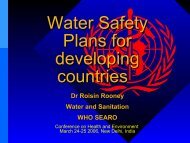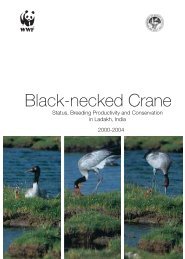DESERTIFICATION - Rainwater Harvesting
DESERTIFICATION - Rainwater Harvesting
DESERTIFICATION - Rainwater Harvesting
You also want an ePaper? Increase the reach of your titles
YUMPU automatically turns print PDFs into web optimized ePapers that Google loves.
Fact 01<br />
factsheet<br />
GLOBAL ENVIRONMENTAL NEGOTIATIONS<br />
ozone depletion<br />
hazardous waste<br />
prior informed consent<br />
right to information<br />
commission on<br />
sustainable development<br />
climate<br />
biodiversity<br />
desertification<br />
persistent organic pollutants<br />
forests<br />
trade and environment<br />
multilateral agreement<br />
on investment<br />
global environment facility<br />
institutions for environment<br />
<strong>DESERTIFICATION</strong><br />
United Nations Convention to Combat Desertification in Those Countries<br />
Experiencing Serious Drought and/or Desertification, Particularly in Africa<br />
In force from December 26, 1996, ratified by 176 countries<br />
(as of August 29, 2001)<br />
Problem<br />
The misuse of land and water in many parts of the world due to deforestation,<br />
agriculture, mining and urbanisation have led to large-scale land degradation in<br />
many parts of the world.<br />
Although desertification is a local phenomenon, its occurrence can be traced<br />
to global trade and economic practices. For example, governments in poor<br />
countries encourage farmers to grow cash crops such as coffee, which<br />
generate foreign exchange to pay back national debt. But such crops also put<br />
an enormous strain on soil and water resources. If export prices of primary<br />
commodities exported by poor countries drop, there is a greater need to exploit<br />
more land. Caught in a cycle of debt and production, farmers tax the soil until it<br />
eventually loses all its nutrients and can no longer sustain agriculture.<br />
Desertification affects 41 per cent of the total land area on earth. The<br />
world’s poor are the worst hit. They depend on the soil for a livelihood but do<br />
not have the resources to reverse desertification. The livelihoods of more than<br />
1 billion people in more than 110 countries are jeopardised. According to 1998<br />
estimates, desertification costs the world US $42 billion a year.<br />
The convention<br />
The persistence of countries from Africa, where two-thirds of the land area is<br />
either desert or dryland, led to the decision to adopt the Convention to Combat<br />
Desertification (CCD) at the 1992 United Nations Conference on Environment<br />
and Development (UNCED). As of August 2001, 176 nations have ratified CCD,<br />
which entered into force on December 26, 1996. A Committee on Science and<br />
Technology (CST) serves as a permanent scientific body of the convention.<br />
The main elements of the convention include establishment of a global legal<br />
framework, creation of a system for exchanging information on ways to combat<br />
desertification, principles that include a ‘bottom-up’ approach to ensure participation<br />
of local populations in combating desertification, and mobilisation of<br />
finances through bilateral and multilateral aid.<br />
Poor subsidise the rich<br />
The primary seed of contention between the North and the South lies in their<br />
respective perceptions of the main causes in the process of desertification.<br />
Northern countries were, and still are unwilling partners in CCD as they do not<br />
acknowledge the global roots of the problem. Instead of over-consumption by<br />
rich countries, they identify population pressures in poor countries as the<br />
cause of desertification. However, over 90 per cent of world trade in physical<br />
natural resource goods and raw materials originate from developing countries,<br />
which end up bearing the environmental cost of the extraction of natural<br />
resources.<br />
The EU and the US have, in particular, questioned any links between desertification,<br />
trade and poverty. Since 1992, they have opposed discussions that<br />
place any obligation on them to provide assistance to Southern countries. They<br />
have resisted the use of the Global Environment Facility (GEF) as a funding
Fact 01<br />
There is a need to<br />
change the perspective<br />
and face, from<br />
a convention designed<br />
to help poor countries<br />
with the problem of<br />
desertification to<br />
a convention that<br />
demands the causal<br />
culprits to pay for<br />
the desertification that<br />
they cause<br />
mechanism for CCD. Southern countries have had to fight for the establishment<br />
of a ‘global mechanism’ (GM) that serves as the funding mechanism for the<br />
convention.<br />
The issue of international economic policies that stimulate desertification<br />
remains unresolved, but as a result CCD is neglected by Northern governments<br />
and non-governmental organisations (NGOs). It has not yet had the chance to<br />
be implemented, due to lack of funds.<br />
GLOBAL<br />
ENVIRONMENTAL<br />
NEGOTIATIONS<br />
This series provides a close analysis<br />
of important environment-related<br />
conventions and institutions from<br />
their origins, and demystifies the<br />
politics of ‘saving the environment’.<br />
A first-ever comprehensive Southern<br />
perspective of the impact of global<br />
environmental governance on the real<br />
lives of real people.<br />
In addition to dealing with five new<br />
issues, the second volume, Poles<br />
Apart contains updates on the issues<br />
dealt with in the first report, Green<br />
Politics. The updates cover only<br />
recent developments — a complete<br />
historical background can be found<br />
in the first report.<br />
Challenges ahead<br />
The CCD could and must play a critical role in bringing to the forefront the<br />
inequitable relationships in international trade and economic policies. But<br />
judging by the current trends, CCD will soon turn into a corpse convention if<br />
drastic measures are not opted for. It suffers from a hangover with administrative<br />
issues, as they trail from conference to conference without being<br />
resolved. Still, important issues like that of the role of the secretariat are to be<br />
resolved even after four Conferences of the Parties (CoPs). Therefore, CCD yet<br />
needs to mobilise adequate funding for programmes to control desertification.<br />
The GM, the convention’s only hope for funding, so far claims that the donor<br />
countries are just not interested.<br />
● The CCD needs to change its perspective and face, from a convention<br />
designed to help poor countries with the problem of desertification to a convention<br />
that demands the causal culprits to pay for the desertification that<br />
they cause. The right linkages between trade and land degradation have to<br />
be made. Desertification demands for strict application of the polluter pays<br />
principle, that is proper pricing of primary commodities, taking into account<br />
ecological costs.<br />
● The ‘bottom-up’ approach for developing national action programmes to<br />
combat desertification must be implemented. Local governance and community<br />
empowerment are yet to become important principles guiding antidesertification<br />
programmes in Southern countries.<br />
● The CST needs a stronger role. Instead of being an advisory body, it has so<br />
far become a body for the documentation of facts. NAPs formulated by the<br />
affected developing countries contain an enormous amount of local region<br />
specific information. CST could play a powerful role in utilising this information,<br />
incorporating it in its own research work and thereby, coming out<br />
with policies, strategies and action plans for implementation.


